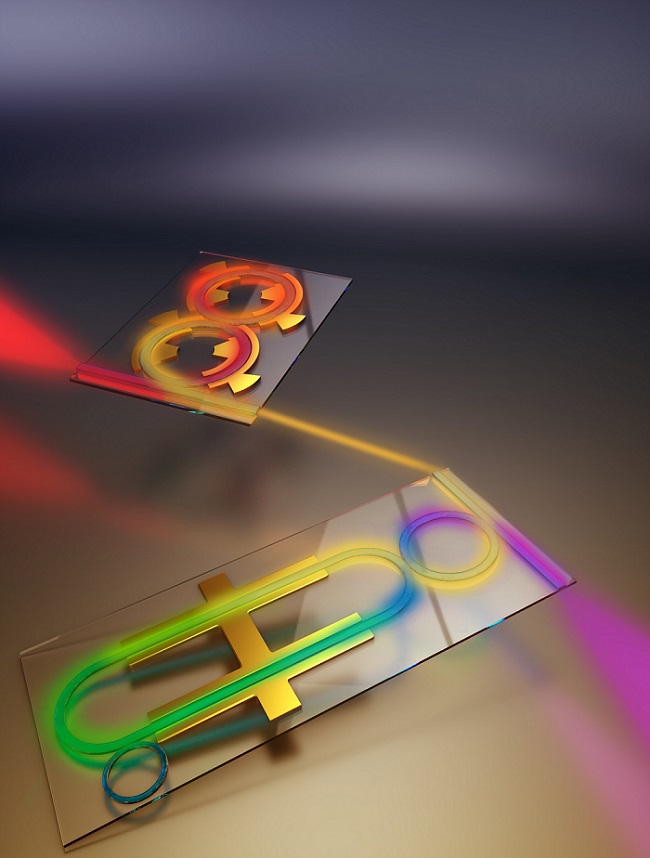Researchers from the Harvard John A. Paulson School of Engineering and Applied Sciences (SEAS) have developed an on-chip frequency shift mechanism that could contribute to the next generation of photonic technologies. Frequency, or color, is among the most difficult properties of a photon to change. Changing a photon’s frequency also means changing its energy.
Currently, most frequency shifters are either too inefficient — losing a lot of light in the conversion process — or unable convert light in the gigahertz range. This range is where the most important frequencies for communications, computing, and other applications are found.

Harvard researchers developed on-chip frequency shifters that they say are poised to support the next generation of communication. Here, in the top device, two coupled resonators form a figure-eight-like structure. Input light travels from the waveguide through the resonators, entering as one color and emerging as another. The bottom device uses three coupled resonators: a small ring resonator, a long oval resonator called a racetrack resonator, and a rectangular-shaped resonator. As light speeds around the racetrack resonator, it cascades into higher and higher frequencies, resulting in a shift as high as 120 GHz. Courtesy of Second Bay Studios/Harvard SEAS.
The team outlined two types of on-chip frequency shifters. One can convert one color to another, using a shift of a few dozen gigahertz. The other can cascade multiple shifts, a shift of more than 100 GHz. Each device is built on a lithium niobate platform created in the lab of Marko Loncar, the Tiantsai Lin Professor of Electrical Engineering at Harvard University and senior author of a paper describing the shifters. The material is known to efficiently convert electronic signals into optical signals, but it was long considered by many in the field to be difficult to work with on small scales.
In previous research, Loncar and his team demonstrated a technique to fabricate high-performance lithium niobate microstructures using standard plasma etching to physically sculpt microresonators in thin lithium niobate films.
In the current work, Loncar and his team used the same technique to etch coupled ring-resonators and waveguides on thin-film lithium niobate.
In the first device, two coupled resonators form a figure-eight-like structure. Input light travels from the waveguide through the resonators in a figure-eight pattern, entering as one color and emerging as another. This device provides frequency shifts as high as 28 GHz with about 90% efficiency. It can also be reconfigured as tunable frequency-domain beamsplitters, where a beam of one frequency gets split into two beams of another frequency.
The second device uses three coupled resonators: a small ring resonator, a long oval resonator called a racetrack resonator, and a rectangular-shaped resonator. As light speeds around the racetrack resonator, it cascades into higher and higher frequencies, resulting in a shift as high as 120 GHz.
“We are able to achieve this magnitude of frequency shift using only a single, 30-GHz microwave signal,” said Yaowen Hu, a research assistant at SEAS and first author of the paper. “This is a completely new type of photonic device. Previous attempts to shift frequencies by amounts larger than 100 GHz have been very hard and expensive, requiring an equally large microwave signal.”
“This work is made possible by all of our previous developments in integrated lithium niobate photonics,” Loncar said. “The ability to process information in the frequency domain in an efficient, compact, and scalable fashion has the potential to significantly reduce the expense and resource requirements for large-scale photonic circuits, including quantum computing, telecommunications, radar, optical signal processing, and spectroscopy.”
According to Loncar, the frequency shifters could ultimately become a fundamental building block for high-speed, large-scale classical communication systems, as well as emerging photonic quantum computers.
The research was published in Nature (www.doi.org/10.1038/s41586-021-03999-x).